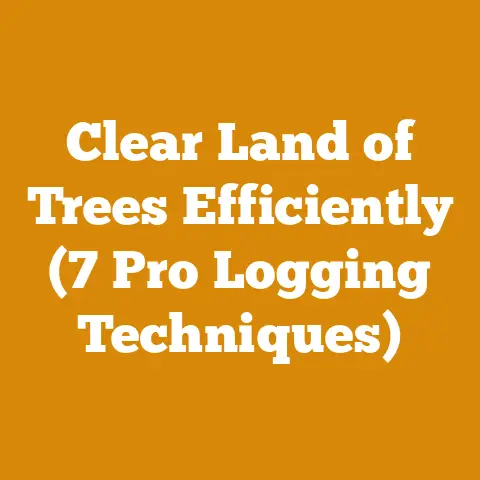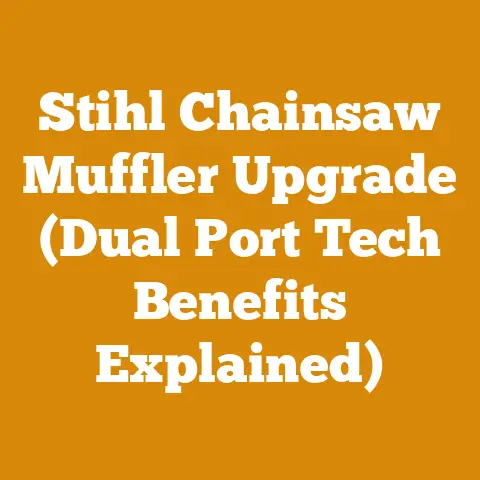Husqvarna 128LD Fuel Line Size Guide (5 Expert Tips)
I’ve seen it happen more times than I can count: someone tries to fix their Husqvarna 128LD trimmer, replaces the fuel lines, and then… nothing. The engine sputters, coughs, and refuses to start. More often than not, the culprit isn’t the quality of the fuel line itself, but rather using the wrong size or routing it incorrectly. Getting those fuel lines right is crucial for reliable performance. That’s why I’ve created this guide to help you navigate the intricacies of Husqvarna 128LD fuel lines. I’m going to share my expert tips, drawn from years of experience wrenching on these machines, to ensure your trimmer runs smoothly and reliably. Let’s dive in!
Husqvarna 128LD Fuel Line Size Guide (5 Expert Tips)
The Husqvarna 128LD is a popular trimmer, known for its reliability and ease of use. However, like any small engine, its performance hinges on a properly functioning fuel system. The fuel lines are critical components, delivering fuel from the tank to the carburetor. Using the wrong size, material, or routing can lead to a host of problems. Let’s get into the specifics.
Understanding the Husqvarna 128LD Fuel System
Before we delve into the specifics of fuel line sizes, it’s essential to understand the basic layout of the fuel system in your Husqvarna 128LD. The system consists of:
- Fuel Tank: Holds the fuel mixture.
- Fuel Filter: Located inside the tank, attached to one of the fuel lines. It filters out debris to prevent clogging.
- Fuel Lines: Hoses that carry fuel from the tank to the carburetor and back.
- Carburetor: Mixes fuel and air for combustion.
- Primer Bulb: A small bulb that, when pressed, draws fuel into the carburetor to aid in starting.
The Husqvarna 128LD typically has two fuel lines: the fuel supply line and the return line. The supply line draws fuel from the tank, through the fuel filter, and to the carburetor. The return line carries excess fuel back to the tank from the carburetor.
Why is Fuel Line Size So Important?
Using the correct fuel line size is vital for several reasons:
- Proper Fuel Flow: The carburetor is designed to work with a specific fuel flow rate. An incorrect fuel line size can restrict or increase fuel flow, leading to poor engine performance.
- Preventing Air Leaks: Loose or poorly fitting fuel lines can allow air to enter the fuel system. Air leaks can cause the engine to run lean, resulting in hard starting, stalling, and potential engine damage.
- Durability: Using fuel lines that are not fuel-resistant can cause them to degrade quickly, leading to leaks and fuel system problems.
- Primer Bulb Functionality: The primer bulb relies on a properly sealed fuel system to function correctly. Incorrect fuel line sizes can prevent the primer bulb from drawing fuel.
Tip #1: Identifying the Correct Fuel Line Sizes
The most common mistake I see is people guessing the fuel line size. Don’t do it! Here’s the accurate information you need:
- Fuel Supply Line (from tank to carburetor): 3/32″ ID (Inner Diameter) x 3/16″ OD (Outer Diameter). This is the line connected to the fuel filter inside the tank.
- Fuel Return Line (from carburetor back to tank): 3/32″ ID x 3/16″ OD. This line is usually shorter and doesn’t have a filter attached.
- Primer Line (from carburetor to primer bulb): 3/32″ ID x 3/16″ OD
Important Note: These are the standard sizes for the Husqvarna 128LD. However, it’s always a good idea to double-check the existing fuel lines before replacing them, especially if the trimmer has been modified or repaired previously.
How to Measure Fuel Line Size
If you’re unsure about the size of your existing fuel lines, you can measure them using a caliper or a set of drill bits. Here’s how:
- Inner Diameter (ID): Use a caliper to measure the inside diameter of the fuel line. Alternatively, try inserting drill bits of different sizes into the fuel line until you find one that fits snugly. The size of the drill bit is the ID of the fuel line.
- Outer Diameter (OD): Use a caliper to measure the outside diameter of the fuel line.
Why Are Specific Dimensions Critical?
The inner diameter (ID) determines the volume of fuel that can flow through the line. A smaller ID restricts fuel flow, while a larger ID can lead to inconsistent fuel pressure. The outer diameter (OD) ensures a snug fit on the carburetor and fuel tank fittings, preventing leaks. Using a fuel line with the wrong OD can result in a loose connection, leading to air leaks and fuel starvation.
Real-World Example:
I once worked on a Husqvarna 128LD where the owner had replaced the fuel lines with a slightly larger size. The trimmer would start, but it ran erratically and stalled frequently. After inspecting the fuel lines, I discovered that the larger ID was causing the carburetor to receive too much fuel, resulting in an overly rich mixture. Replacing the fuel lines with the correct size (3/32″ ID) solved the problem immediately.
Takeaway: Always use the correct fuel line sizes (3/32″ ID x 3/16″ OD) for your Husqvarna 128LD. Measuring the old lines or referring to the manufacturer’s specifications can prevent performance issues.
Tip #2: Choosing the Right Fuel Line Material
The material of the fuel line is just as important as the size. Not all fuel lines are created equal, and using the wrong type can lead to premature failure and fuel system problems.
Recommended Materials:
- Tygon Fuel Line: This is the gold standard for small engine fuel lines. Tygon is a synthetic rubber that is highly resistant to gasoline, oil, and other chemicals. It’s also flexible and durable, making it ideal for use in demanding applications. I personally prefer Tygon for its long lifespan and resistance to hardening and cracking.
- Viton Fuel Line: Viton is another excellent choice for fuel lines. It offers similar chemical resistance to Tygon and is also very durable. Viton is often used in applications where high temperatures are a concern.
- Polyurethane Fuel Line: Polyurethane fuel lines are a more affordable option. They are resistant to fuel and oil, but they are not as durable as Tygon or Viton. Polyurethane fuel lines can become brittle and crack over time, especially when exposed to sunlight and extreme temperatures.
Materials to Avoid:
- Vinyl Tubing: Vinyl tubing is not fuel-resistant and will quickly degrade when exposed to gasoline. It will become hard, brittle, and eventually crack, leading to fuel leaks and engine problems.
- Rubber Hose: Standard rubber hose is not designed for use with gasoline. It will swell, soften, and eventually deteriorate, causing fuel leaks and engine damage.
Why Material Matters:
The fuel line material must be able to withstand the corrosive effects of gasoline and oil. Gasoline can dissolve or degrade certain materials, leading to leaks and fuel system contamination. A fuel line that is not fuel-resistant will also become brittle and crack over time, especially when exposed to sunlight and temperature extremes.
Personal Experience:
I once tried to save money by using a cheap vinyl tubing for a fuel line replacement. Within a few weeks, the tubing had become hard and brittle, and it started to leak. I ended up having to replace it with a Tygon fuel line, which has lasted for years without any problems. This experience taught me that it’s always worth investing in high-quality fuel lines.
Case Study:
A local landscaping company was experiencing frequent fuel line failures on their Husqvarna trimmers. They were using a generic rubber hose that was not fuel-resistant. After switching to Tygon fuel lines, they saw a significant reduction in fuel line failures and improved the reliability of their equipment.
Takeaway: Choose fuel lines made from Tygon, Viton, or polyurethane for your Husqvarna 128LD. Avoid using vinyl tubing or standard rubber hose, as they are not fuel-resistant and will degrade quickly. Investing in high-quality fuel lines will save you time and money in the long run.
Tip #3: Proper Fuel Line Routing and Installation
Even with the correct size and material, improper fuel line routing can cause problems. Kinks, bends, or contact with hot engine components can restrict fuel flow and damage the fuel lines.
Step-by-Step Installation Guide:
- Remove the Old Fuel Lines: Carefully disconnect the old fuel lines from the carburetor and fuel tank. Use a pair of pliers or a small screwdriver to gently pry the lines off the fittings. Be careful not to damage the fittings.
- Inspect the Fittings: Check the carburetor and fuel tank fittings for damage or corrosion. Clean the fittings with a wire brush or sandpaper if necessary.
- Cut the New Fuel Lines to Length: Measure the length of the old fuel lines and cut the new fuel lines to the same length. It’s better to cut the lines slightly longer than necessary, as you can always trim them later.
- Install the Fuel Filter: Attach the fuel filter to one end of the fuel supply line. Make sure the filter is securely attached and facing the correct direction (the arrow on the filter should point towards the carburetor).
- Connect the Fuel Lines to the Carburetor: Attach the fuel lines to the carburetor fittings. Make sure the lines are securely attached and that there are no kinks or bends.
- Connect the Fuel Lines to the Fuel Tank: Insert the fuel supply line (with the fuel filter attached) into the fuel tank. Make sure the filter reaches the bottom of the tank. Attach the fuel return line to the remaining fitting on the fuel tank.
- Secure the Fuel Lines: Use zip ties or small hose clamps to secure the fuel lines in place. This will prevent them from rubbing against other components or becoming disconnected.
- Prime the Fuel System: Press the primer bulb several times to draw fuel into the carburetor. The primer bulb should become firm as fuel fills the system.
- Start the Engine: Start the engine and check for fuel leaks. If you see any leaks, tighten the fuel line connections or replace the fuel lines if necessary.
Routing Tips:
- Avoid Kinks and Bends: Make sure the fuel lines are routed in a way that avoids kinks and sharp bends. Kinks and bends can restrict fuel flow and cause the engine to run poorly.
- Keep Away from Heat: Keep the fuel lines away from hot engine components, such as the exhaust manifold. Heat can cause the fuel lines to degrade and crack.
- Secure the Lines: Use zip ties or hose clamps to secure the fuel lines in place. This will prevent them from rubbing against other components or becoming disconnected.
- Check for Clearance: Make sure the fuel lines have enough clearance to move freely without rubbing against other components. Rubbing can cause the fuel lines to wear through and leak.
- Use the Original Routing: Whenever possible, follow the original routing of the fuel lines. This will ensure that the lines are properly positioned and that they don’t interfere with other components.
Common Mistakes to Avoid:
- Over-Tightening Clamps: Over-tightening hose clamps can damage the fuel lines and fittings. Tighten the clamps just enough to secure the lines in place.
- Using the Wrong Size Clamps: Using clamps that are too large or too small can also damage the fuel lines. Use clamps that are the correct size for the fuel lines.
- Forgetting the Fuel Filter: The fuel filter is essential for preventing debris from entering the carburetor. Always install a new fuel filter when replacing the fuel lines.
- Routing Lines Incorrectly: Incorrect routing can lead to kinks, bends, and contact with hot engine components. Follow the original routing as closely as possible.
My Personal Tip: I always take a picture of the fuel line routing before I remove the old lines. This serves as a visual guide when I’m installing the new lines, ensuring that I route them correctly.
Takeaway: Proper fuel line routing is essential for ensuring reliable engine performance and preventing fuel leaks. Follow the steps outlined above to install the fuel lines correctly. Avoid kinks, bends, and contact with hot engine components. Secure the lines in place with zip ties or hose clamps.
Tip #4: Diagnosing Fuel Line Problems
Sometimes, even with the correct fuel lines and proper installation, you might still experience fuel system problems. Here’s how to diagnose some common issues:
Symptoms of Fuel Line Problems:
- Hard Starting: The engine is difficult to start, even after priming.
- Stalling: The engine starts, but stalls frequently, especially at idle.
- Poor Performance: The engine lacks power and runs erratically.
- Fuel Leaks: Fuel is leaking from the fuel lines or fittings.
- Primer Bulb Not Filling: The primer bulb doesn’t fill with fuel when pressed.
Troubleshooting Steps:
- Check for Fuel Leaks: Inspect the fuel lines and fittings for any signs of leaks. If you find a leak, tighten the connections or replace the fuel lines if necessary.
- Inspect the Fuel Lines for Damage: Check the fuel lines for cracks, kinks, or other damage. Replace the fuel lines if they are damaged.
- Check the Fuel Filter: Remove the fuel filter and inspect it for clogs. If the filter is clogged, replace it with a new one.
- Check the Primer Bulb: Inspect the primer bulb for cracks or damage. If the bulb is cracked or damaged, replace it. Also, check the lines connected to the primer bulb.
- Check the Carburetor: The carburetor is a complex component, and problems with the carburetor can often mimic fuel line issues. Consider cleaning or rebuilding the carburetor if you suspect a problem.
- Check the Fuel Tank Vent: A clogged fuel tank vent can prevent fuel from flowing properly. Clean the vent with a wire brush or compressed air.
Using a Vacuum Tester:
A vacuum tester can be a useful tool for diagnosing fuel line problems. Here’s how to use it:
- Disconnect the Fuel Line: Disconnect the fuel line from the carburetor.
- Attach the Vacuum Tester: Attach the vacuum tester to the fuel line.
- Pump the Vacuum Tester: Pump the vacuum tester to create a vacuum in the fuel line.
- Observe the Vacuum Reading: If the vacuum reading drops quickly, it indicates a leak in the fuel line or fuel tank.
Common Scenarios:
- Primer Bulb Not Filling: This is often caused by a cracked primer bulb, a clogged fuel filter, or a leak in the fuel lines.
- Engine Starts But Stalls: This can be caused by a clogged fuel filter, a kinked fuel line, or a carburetor problem.
- Fuel Leaks: Fuel leaks are usually caused by damaged fuel lines, loose fittings, or a cracked fuel tank.
My Troubleshooting Story:
I once had a Husqvarna 128LD that was hard to start and would stall frequently. I checked the fuel lines, the fuel filter, and the primer bulb, but everything seemed to be in good condition. Finally, I decided to take a closer look at the carburetor. I discovered that the carburetor was clogged with debris. After cleaning the carburetor, the trimmer ran perfectly. This experience taught me that it’s important to consider all possible causes when troubleshooting fuel system problems.
Takeaway: Diagnosing fuel line problems requires a systematic approach. Check for leaks, inspect the fuel lines for damage, check the fuel filter, and check the primer bulb. Use a vacuum tester to identify leaks. Remember to consider other potential causes, such as carburetor problems.
Tip #5: Preventative Maintenance for Fuel Lines
Preventative maintenance is key to keeping your Husqvarna 128LD running smoothly and avoiding fuel line problems. Here are some tips:
Regular Inspection:
- Inspect Fuel Lines Regularly: Check the fuel lines for cracks, kinks, or other damage at least once a month.
- Check Fuel Filter Regularly: Inspect the fuel filter for clogs at least once a month. Replace the filter if it is dirty or clogged.
- Check Primer Bulb Regularly: Inspect the primer bulb for cracks or damage at least once a month. Replace the bulb if it is cracked or damaged.
Fuel Stabilization:
- Use Fuel Stabilizer: Add fuel stabilizer to the fuel tank when storing the trimmer for extended periods. Fuel stabilizer prevents the fuel from breaking down and forming gum and varnish, which can clog the fuel lines and carburetor. I recommend using a fuel stabilizer like Sta-Bil.
- Drain Fuel Before Storage: If you’re storing the trimmer for more than a month, drain the fuel tank completely. This will prevent the fuel from breaking down and causing problems.
Proper Storage:
- Store in a Cool, Dry Place: Store the trimmer in a cool, dry place, away from direct sunlight and extreme temperatures. Sunlight and extreme temperatures can cause the fuel lines to degrade and crack.
- Protect from Pests: Store the trimmer in a location where pests, such as rodents, cannot access it. Rodents can chew on the fuel lines, causing leaks and other damage.
Cleaning:
- Clean the Fuel Tank: Periodically clean the fuel tank to remove any debris or sediment that may have accumulated.
- Clean the Carburetor: Clean the carburetor periodically to remove any gum or varnish that may have formed.
Maintenance Schedule:
- Monthly: Inspect fuel lines, fuel filter, and primer bulb.
- Every 6 Months: Clean the fuel tank and carburetor.
- Annually: Replace the fuel lines and fuel filter.
My Maintenance Routine:
I make it a habit to inspect my Husqvarna 128LD’s fuel lines every time I use it. Before I start the engine, I give the fuel lines a quick visual check for cracks, kinks, or leaks. I also check the fuel filter and the primer bulb. This simple routine has helped me catch potential problems early and prevent them from escalating into major repairs.
Takeaway: Preventative maintenance is essential for keeping your Husqvarna 128LD running smoothly and avoiding fuel line problems. Inspect the fuel lines, fuel filter, and primer bulb regularly. Use fuel stabilizer when storing the trimmer for extended periods. Store the trimmer in a cool, dry place, away from direct sunlight and extreme temperatures.
By following these five expert tips, you can ensure that your Husqvarna 128LD fuel lines are in top condition, providing reliable performance and preventing costly repairs. Remember to use the correct fuel line sizes (3/32″ ID x 3/16″ OD), choose fuel lines made from Tygon or Viton, route the fuel lines properly, diagnose fuel line problems effectively, and perform preventative maintenance regularly. With a little care and attention, your Husqvarna 128LD will be running smoothly for years to come.






